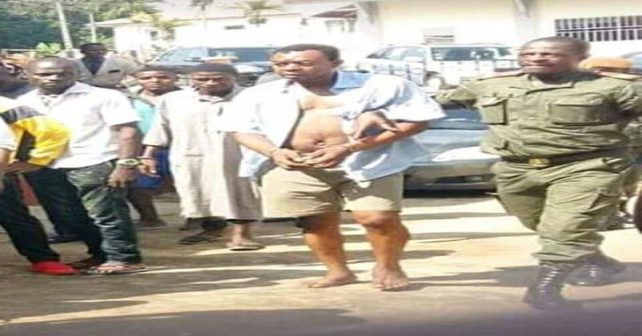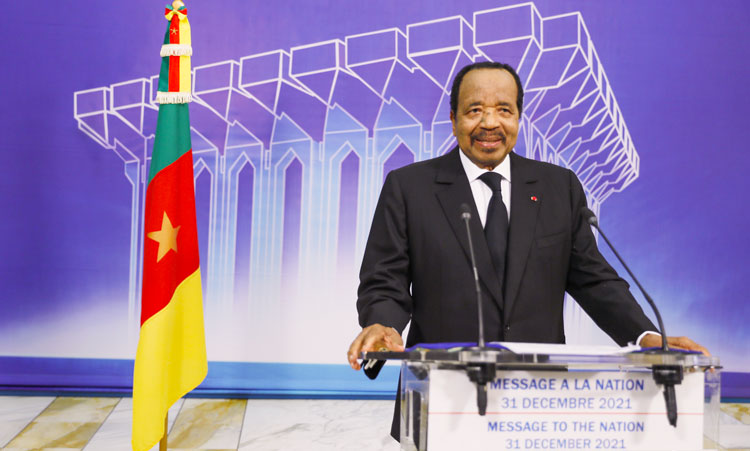Categories
Recent Posts
- Football: De Bruyne to leave Man City at end of the season
- Southern Cameroons Crisis: Brit missionary and assistant abducted, church begs for their release
- Prosecution of journalists in Cameroon: European Parliament says enough red flags have been ignored
- Race for the Unity Palace: Kamto’s strategy sparks clash ahead of election
- CEMAC introduces new coins, including a CFA200 piece
Archives
- April 2025
- March 2025
- February 2025
- January 2025
- December 2024
- November 2024
- October 2024
- September 2024
- August 2024
- July 2024
- June 2024
- May 2024
- April 2024
- March 2024
- February 2024
- January 2024
- December 2023
- November 2023
- October 2023
- September 2023
- August 2023
- July 2023
- June 2023
- May 2023
- April 2023
- March 2023
- February 2023
- January 2023
- December 2022
- November 2022
- October 2022
- September 2022
- August 2022
- July 2022
- June 2022
- May 2022
- April 2022
- March 2022
- February 2022
- January 2022
- December 2021
- November 2021
- October 2021
- September 2021
- August 2021
- July 2021
- June 2021
- May 2021
- April 2021
- March 2021
- February 2021
- January 2021
- December 2020
- November 2020
- October 2020
- September 2020
- August 2020
- July 2020
- June 2020
- May 2020
- April 2020
- March 2020
- February 2020
- January 2020
- December 2019
- November 2019
- October 2019
- September 2019
- August 2019
- July 2019
- June 2019
- May 2019
- April 2019
- March 2019
- February 2019
- January 2019
- December 2018
- November 2018
- October 2018
- September 2018
- August 2018
- July 2018
- June 2018
- May 2018
- April 2018
- March 2018
- February 2018
- January 2018
- December 2017
- November 2017
- October 2017
- September 2017
- August 2017
- July 2017
- June 2017
- May 2017
- April 2017
- March 2017
- February 2017
- January 2017
- December 2016
- November 2016
- October 2016
- September 2016
- August 2016
- July 2016
- June 2016
Featured
 Prosecution of journalists in Cameroon: European Parliament says enough red flags have been ignored
Prosecution of journalists in Cameroon: European Parliament says enough red flags have been ignored  1982-2025: How long will Biya hang on?
1982-2025: How long will Biya hang on?  How Biya and Archbishop Nkea protected the sanctity of the family in Cameroon
How Biya and Archbishop Nkea protected the sanctity of the family in Cameroon  October Presidential Election: Will 92-year-old Biya be re-elected?
October Presidential Election: Will 92-year-old Biya be re-elected?  Why is Biya seeking re-election?
Why is Biya seeking re-election?
Most Commented Posts
 4 Anglophone detainees killed in Yaounde
4 Anglophone detainees killed in Yaounde
18 comments Chantal Biya says she will return to Cameroon if General Ivo Yenwo, Martin Belinga Eboutou and Ferdinand Ngoh Ngoh are sacked
Chantal Biya says she will return to Cameroon if General Ivo Yenwo, Martin Belinga Eboutou and Ferdinand Ngoh Ngoh are sacked
13 comments The Anglophone Problem – When Facts don’t Lie
The Anglophone Problem – When Facts don’t Lie
12 comments Anglophone Nationalism: Barrister Eyambe says “hidden plans are at work”
Anglophone Nationalism: Barrister Eyambe says “hidden plans are at work”
12 comments Largest wave of arrest by BIR in Bamenda
Largest wave of arrest by BIR in Bamenda
10 comments
Latest Tweets
Featured
-

Football: De Bruyne to leave Man City at end of the season
-

Southern Cameroons Crisis: Brit missionary and assistant abducted, church begs for their release
-

Prosecution of journalists in Cameroon: European Parliament says enough red flags have been ignored
-

Race for the Unity Palace: Kamto’s strategy sparks clash ahead of election
-

CEMAC introduces new coins, including a CFA200 piece
-

Football: Real Madrid manager Ancelotti testifies in court over tax charges
-

Manyu Division: Ma Nchong Stella is the new Ekandim Nkanda of Ntenako
© Cameroon Concord News 2025
23, September 2024
Far North Flooding: Dion Ngute commits to investigating root causes 0
Prime Minister Joseph Dion Ngute chaired a high-level interministerial meeting in Yaoundé on September 19, 2024. The meeting, between governors, regional councilaors and government officials, aimed to address the devastating floods that have caused significant loss of life and extensive property damage in the Far North. According to the national radio, the government reaffirmed its commitment to investigating the “underlying causes” of the flooding and implementing “new preventive measures,” in line with directives from President Paul Biya.
During a 2022 visit to the flood-stricken Yagoua, the capital of the Mayo-Danay department in the Far North, Territorial Administration Minister Paul Atanga Nji stated that President Biya had requested a thorough study of the causes of the flooding and the necessary measures to address the problem. Local officials in Yagoua pointed out at the time that rivers in northern Cameroon often converge, and rainfall in the Adamaoua region swells the Logone River, exacerbating the flooding. However, a more comprehensive study is still needed to accurately determine the causes.
In the meantime, the government has announced that President Biya has released over 1.6 billion CFA francs to assist affected populations and rebuild critical infrastructure destroyed by the floods, primarily in the Far North region. Paul Atanga Nji began a working visit to the flooded areas on Thursday, where he is meeting with those impacted and distributing humanitarian aid, including temporary shelters, mattresses, blankets, food supplies, and sanitary kits.
The recent floods in the Far North, particularly in the Diamaré, Logone-and-Chari, Mayo-Danay, and Mayo-Tsanaga departments, have wreaked havoc. According to the UN’s Office for the Coordination of Humanitarian Affairs (OCHA), as of September 10, 2024, more than 18,000 homes had been destroyed, tens of thousands of hectares of crops flooded, and thousands of livestock lost. Over 33,000 households, representing around 236,000 people, have been affected, including more than 38,000 women of reproductive age and over 4,000 pregnant women. The provisional death toll stands at 17, and schools and health centers have been inundated, according to the Far North’s Governor, Midjiyawa Bakari.
Immediate priority needs include food, shelter, essential household items, and water, hygiene, and sanitation (WASH) services. Local authorities and humanitarian partners are implementing emergency measures to ensure the safety of people and property, including reinforcing the Logone River dike. However, continued rainfall and rising water levels pose an increasing risk of further deterioration and potential outbreaks of disease in the coming days and weeks, OCHA warns.
Source: Sbbc